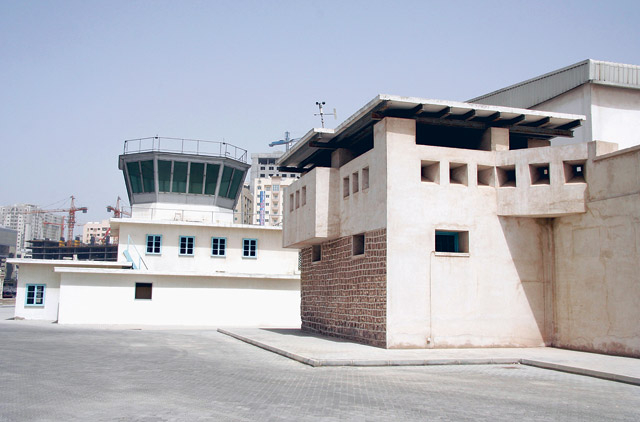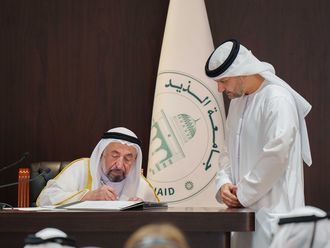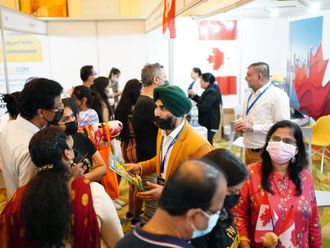
Millions of tourists annually travel to the Middle East to marvel at its heritage of past centuries, like the great pyramids at Giza in Egypt or the rock- cut architecture at Petra in Jordan.
In most cases, these visits are crucial to the growth of developing economies, as the profits from past treasures allow developing nations to step into the future.
Archaeologists in the UAE have unearthed ancient treasures dating back as far as 5,000 years as a result of decades of digging - yet, not many people know this.
Consequently, such lack of awareness has a negative effect on the heritage conservation profession and industry which is already struggling to survive.
"There is a lack of skilled professionals specialised or qualified to work in this area [archaeology and heritage conservation]," said Zaki Aslan, Director of the ATHAR Programme. "Very few people have followed formal education in this field which has resulted in a lack of skills and knowledge not only in the UAE but the whole region," he added.
Aslan said the archaeological field offers an array of professions on various levels from skilled craftsmen to heritage site managers, but is a profession in need of extensive development.
"It is a profession that doesn't even exist," said Peter Jackson, architect at the Sharjah Ruler's Office and Chair of the ATHAR project committee. "Which is what we are trying to do through ATHAR, which is train professionals in this field," he added.
"There are no universities in the UAE training professionals in this field," said Aslan. "There are some universities in Al Ain that offer history programmes where students graduate as historians and archaeologists, but most of them lack practical experience," he added.
ATHAR means heritage
"The problem with universities in developing countries is there is no link or coordination between them," said Professor Mufid Samarai, senior adviser at the Sharjah Academy for Scientific Research (SASR) and ex-civil engineering professor at the University of Sharjah (UOS). "In developed nations when academics publish papers about their archaeological findings everyone can access them, because they have established networks. Here, regional professionals in this field are rare and there is no connection between them," he added.
For this reason the International Centre for the Study of the Preservation and Restoration of Cultural Property (ICCROM), based in Rome developed the ATHAR programme for the region.
Since 2008 ICCROM has partnered with the Sharjah Ruler's Office, the Sharjah Department of Information and Culture, the Sharjah Museums Department, the American University of Sharjah (AUS) and UOS - to develop the profession of heritage conservation and restoration in the Middle East.
The aim is to do this through professional training programmes and the development of institutional and academic networks - with Sharjah at its core.
Awareness
However, there is an evident lack of awareness particularly in the Gulf region and the UAE about the importance of heritage conservation. "Government bodies have to recognise the importance of heritage conservation. The media, too, needs to realise this and spread awareness in the community to make young and future generations aware of it," said Samarai.
"The young generation is the key in addressing this problem because they are the custodians of heritage in the future," said Aslan. "Long-term planning and efforts have been made at schools and universities about protecting the environment. Heritage needs to be included in this campaign, because it is part of the build environment. Yet few decision makers are aware of the need to enhance and improve education [in this field] at the university level," he added.
Education
However, Samarai believes there is no point introducing educational programmes when students are unaware and not interested in the field.
"Even if we launch programmes we will have to hunt for people to fill them up…love for one's heritage should be and is usually embedded in the primary educational system with classes and museum visits," said Samarai.
"It has to start from the base. Once the young generation is educated about the importance of heritage, the government will then realise its importance because students will go to universities and ask for the programmes. Once the seed of interest is planted it then becomes an industry," he added.
Building an industry
"The youth don't care, maybe because governments don't care," said Jackson. "Heritage conservation gets very low priority on national budgets, in the region and internationally, which is a constant problem we have," he said.
He added that more often than not, conservation gets tagged with tourism.
"Tourism has an economic benefit, yet often conservation is just lip-service, given no resources, with minimum funding and staffing. Yet we have incredibly rich archaeology in the UAE for instance…the more we dig the more we find," said Jackson.
"We don't look at heritage sites as fossils because they are part of the meaning of the city or place," said Aslan. "If we think about historic cities they become part of the living heritage and directly relate to the quality of life for a society," he added.
"Heritage sites offer economic value, which helps enhance the tourism income of a country, which in turn affects the national income and revenues," said Aslan.
Future generations
Aslan added that a heritage industry, if it were to exist in the UAE and the region, would open up a whole new career path for future generations.
He explained that the development of such an industry would create vacancies for professionals directly related to heritage conservation, such as site and artefact conservationists, scientists to develop materials and technologies for sustainable preservation and skilled craftsmen.
But the benefits of the creation of such an industry would also spill over into virtually all fields, such as education, tourism, media and business, increasing not only employment demand but economic benefits. Alas, such possibilities all begin with education.
Discovered heritage sites:
- Jebel Al Buhais in Sharjah: Archaeologists found 6,000 year old graves buried with jewels
- Mleiha in Sharjah: Archaeologists found a 2,000-year-old castle with 4,000-year-old tombs
- The mountains of Musandam: Where archaeologists discovered the Sumerian civilisation extracted their copper
- Tal Abrak, on the border of Umm Al Quwain: is a 4,000-year-old mount occupied for over 2,500 years
- Al Dur, north of Umm Al Quwain: The largest pre-Islamic site on the Gulf coast with 2,000-year-old ruins, a temple two metres high and Roman luxury goods
- Al Julfa in Ras Al Khaimah: A medieval site which was a major port in the lower Gulf up until the early 18th century













